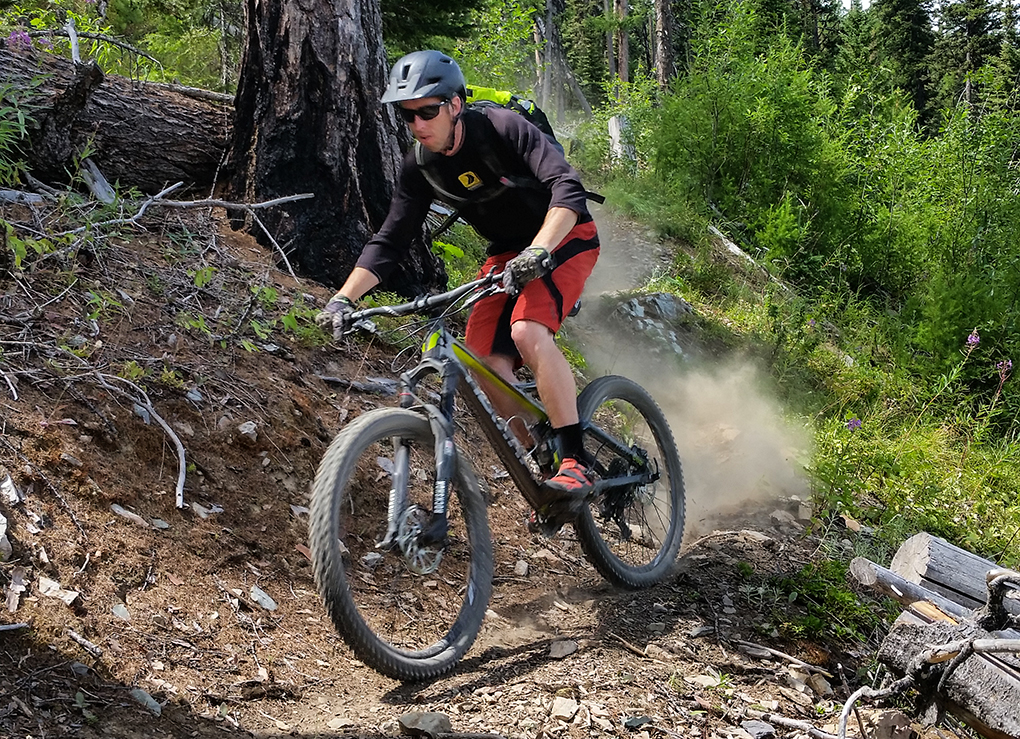The Build
The Troy has four different build kit options, each of which is available on either an aluminum or carbon frame. The bike tested was the Carbon SX build, which is a notch down from the top of the line RR version. The Carbon SX has the exact same parts package as the Aluminum SX version, the only difference is the frame material.
Suspension duties throughout the 2015 Troy lineup are handled by Rockshox, and the SX build has a Monarch RT3 Debonair controlling 140mm of travel in the rear, mated with a Pike RC set at 150mm travel in the front.
The Monarch series of shocks are pretty solid, and the unit on the Troy was no different. I’ll talk more about the actual suspension setup below, but the Monarch performed without any issues. I was left wishing for some compression adjustments (other than the 3-position switch), but the Monarch is no different in this regard than most other comparable shocks.
Similarly, the Pike up front provides a stiff chassis with great small bump compliance. The Pike spec’d on the Troy is a dual position air model with a travel adjustment, and while I’m not a huge fan of travel adjustable forks, they are nice when the going gets legitimately steep.
The one downside here is that, up until very recently, bottomless tokens weren’t available for dual position air Pikes, which is a bummer because I would have preferred the fork to be more progressive.

The drivetrain on the SX build is a SRAM X1 affair, and as I mentioned in my previous review, it works great. It’s not quite as smooth and snappy as the higher end 11-speed drivetrains, but it gets the job done very competently.
Braking is handled by the SRAM Guide R’s, the lower end version of the Guide RSC’s that I rode last summer. While the Guide R’s miss out on the contact point adjustment, the biggest difference is that the Guide RSC uses SRAM’s “swinglink” actuation, whereas the Guide R has SRAM’s “directlink” actuation.
That is all about how the lever actuates the hydraulic piston, and the real world ramification is that the Guide R has a more firm lever feel, but a little less modulation. Ultimately, I didn’t find this to be a huge deal. The Guide R’s still have better modulation than their primary competitor, the Shimano XT’s.
The SX build comes stock with semi-generic wheels: Jalco rims laced to Formula hubs. The top of the line RR model comes with a DT Swiss M1700 wheelset, but as I noted in my Spartan review, those things have dismally poor engagement. The Jalco / Formula wheels were better on the engagement front, but they lose some points for being pretty hefty.
In my relatively short time on the Troy, I didn’t have any issues with the wheels; they stayed reasonably true, and I didn’t have any issues with the spokes unwinding.
I should note, however, that the rims aren’t ideal for setting tires up tubeless. They don’t lock in the tire bead nearly as tightly as many of the newer rims that are designed with tubeless setups in mind.
Those wheels come mounted up with Schwalbe Hans Dampfs, and while those aren’t my favorite tires ever, they get the job done. On the downside, they only get the job done for a couple weeks before the knobs start ripping off, which is an issue I’ve had with most Schwalbe tires.
The rest of the parts are rounded out with pretty straightforward bits and pieces. The Reverb seatpost is internally routed and works great. Perched atop that post is an SDG Belair 2 saddle, which fit my ass really well, even on long rides. A Raceface Chester stem is mated to a V2 riser bar, and while those parts are a bit heavy, Devinci gets kudos for including a 780mm-wide bar.
Suspension Setup
I went into the suspension setup on the Troy thinking it was going to be pretty similar to the Spartan—which is to say, I thought I could get it in the right ballpark and call it good. I find that the Spartan is thoroughly unpicky about air pressure and sag in the rear, and that it rides well (albeit a bit differently) at a wide range of settings.
I pretty quickly realized that the Troy is not just a scaled down Spartan, and the suspension setup was going to need to be a bit more exact. I started with the rear suspension at a bit over 30% sag (which is what I’m running in the Spartan), but I found I was bottoming the bike out really hard, really often.

I struggled to find a happy medium where the suspension was both supple over small bumps, but also wouldn’t get crushed on bigger hits. After a bunch of fussing, I shoved a bunch of grease into the Debonair can to reduce the air volume on the rear shock to make the rear end a bit more progressive. I settled on running 205psi, which set the sag at about 28% when I was seated.
In the front, as I noted above, I was having some similar issues: I was bottoming out too frequently.
Since bottomless tokens weren’t yet available for the dual position air Pike, I settled for just running more air pressure; I was running about 10 psi over Rockshox’s recommended 92psi for my weight. On the upside, even when over pressurized, the Pike has great small bump sensitivity, so I was still pretty happy with the front end.
NEXT: The Ride
